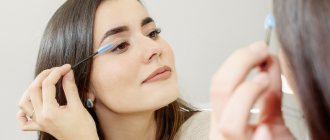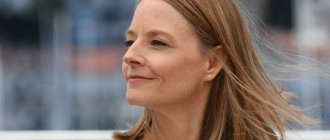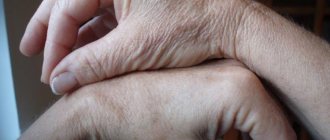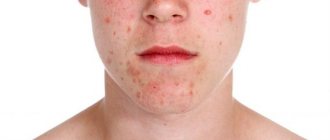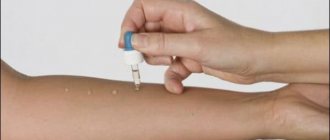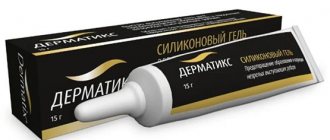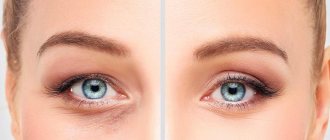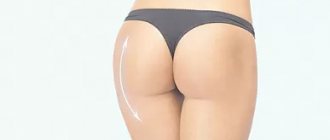A little about Anastasia Dubinskaya
A convincing example that the nose can be made beautiful without the intervention of surgeons is Anastasia Dubinskaya herself. She received an excellent medical education, which allowed her to understand the anatomy of her nose and correct its shape without plastic surgery. “The body does not need to grow a nose,” says Anastasia. “He has enough to do without it.” All the basic techniques for eliminating swelling ennoble the nose. It is important to remove barriers to free circulation of fluid and restore lymph flow.”
“Revitonika” methods help to lift the tip of the nose, so Anastasia successfully turned her Armenian nose into a Greek one. Dubinskaya's students say that the girl uses the same practice in her courses.
Topographic-anatomical features of the nose in childhood
[Home] [To volume contents] I.E.
Davydov (Kharkov) As Peter points out, the nasal cavity in a newborn and in early childhood is not a reduced reflection of the organ of an adult: as it grows, not only the size and shape of the cavity changes, but also the relationship of the individual parts that form it. The shape and size of the external nose and its cavity reach almost final development during puberty. There is a well-known pattern in the growth of all sections and parts that make up the nasal cavity.
Various deviations from the normal course of development consist in a delay or discrepancy in the growth of individual components of the nasal cavity. The result of such abnormal development in the embryonic period is congenital deformities. Disruption of the pattern of growth of individual parts in the postembryonic period is the most important factor in the extremely diverse variations in the sizes and shapes of both the cavity and the external nose in adults.
The external nose of a newborn, compared to the nose of an adult, appears shortened, flattened and somewhat widened. The bridge of the nose in a newborn is also flattened. The saddle between the bridge of the nose and the frontal tubercle, characteristic of an adult, is smoothed out in a newborn due to the still weak development of the frontal tubercle. The tip of the nose in young children is slightly raised and, due to the softness of the cartilage that forms the wings of the nose, is more mobile. The wings of the nose are small, their edges are rounded, and their contours are softer than those of an adult. The nostrils are slightly stretched in the horizontal direction and their plane is closer to the vertical. Subsequently, if the facial skeleton, which determines the shape of the external nose, develops correctly, the external nose gradually takes on the shape characteristic of an adult. The final size and shape of the external nose are determined only during puberty. This age-related evolution is clearly represented in the schematic drawing of the nose profile (Fig. 1).
Rice. 1. Diagram of the profile of the nose from the shape of the organ in a newborn to the shape in an adult (according to Peter). |
Age-related changes in the shape of the external nose are subject to significant individual deviations from the above diagram. Already in the newborn and in early childhood, significant variations occur. With age they are detected even more often. This depends, as has already been said, to a large extent on the discrepancy between the growth energy of the individual bone and cartilaginous components that form the nasal cavity. For example, if the growth of the bottom of the nasal cavity, formed by the hard palate, is delayed in width, and the growth of the nasal septum in height is accelerated, then the hard palate can bend upward and move the septum upward, causing the external nose to become humpbacked. When the growth of the nasal bones in length and the growth of the septum in height slows down, as in achondroplastic dwarfs (Gregory), and the bone components of the upper jaw grow in height normally or even accelerate their growth, the result is a nose with a noticeably upturned tip and a sunken back.
[to contents]
Why does the nose grow larger over the years?
The anatomical specificity of the skull is a decrease in the volume of the nasal bones and an increase in the parameters of the pyriform opening. With age, the muscular skeleton also transforms: the lateral zones are reduced, elasticity is lost. This not only negatively affects the shape of the nose, but also interferes with the outflow of lymph.
Yakutsk has become the capital of “Total Dictation” in 2022
Unique strains of bacteria from the ISS are used in terrestrial crop production
A new walking trail allows you to travel through the forests of the Baltic states (Video)
Another reason for changes in the nose is swelling of the tissues, due to which its size increases even more.
The reverse process steps look like this:
- Eliminate swelling with self-massage.
- Relieving muscle spasms through special exercises.
- Periosteal massage.
Did you know that the nose and ears do not stop growing until the end of our days?
The nose is the most noticeable part of the human face
Due to the fact that skin tissues lose their elasticity and sag over time, the nose begins to visually become larger and larger. Just as earlobes begin to stretch and sag with age, so the tip of the nose begins to sink lower and lower. As the skin ages, the production of collagen and elastin slows down, the skin becomes less elastic and is no longer able to withstand the force of gravity. The visual effect is aggravated by the fact that other parts of the face, cheeks and lips, also lose their volume over time. All this leads to the fact that the nose and ears begin to become more and more conspicuous, and their shape, unfortunately, does not change for the better with age.
The blind, after gaining sight, said that the first thing they noticed in a person’s face was the nose. The nose seemed a surprisingly unattractive organ, standing out unreasonably on the human face. Our patients also complained about this problem. Men with short hair find it difficult to divert attention from their “unloved” nose, while women try every day with their hair or makeup to achieve harmony and visually “reduce” their nose. Some people avoid mirrors in fitting rooms so as not to see themselves in profile, and many spend years erasing photographs that show them from a bad angle.
There are various trends in the choice of nose shape - Asians prefer Caucasian noses with a high bridge. In Europe, they don’t like hooked noses and choose straight or slightly snub-nosed versions. Since the tip of the nose can give away a person's age, patients generally prefer a nose tip that looks up rather than down. Curvatures and deformations, post-traumatic or genetic, are unpleasant for anyone. In the Middle East, a nose job is even an indicator of wealth, and patients do not rush to remove the patch after surgery, but wear it with pride. There is no exact formula for a beautiful nose; proportions are important here. A large nose will not suit a petite face, and a small nose on a large face will simply look funny.
Rhinoplasty is an extremely delicate job
Rhinoplasty is inherently a complex and delicate operation, which requires the hand of a real artist. Particularly delicate work is modeling the tip of the nose.
Many people think that the nose consists of two parts, bone and cartilage, but this opinion is wrong. In fact, the tip of the nose is formed by several pairs of extremely thin lateral cartilages. To sculpt the tip of the nose, an “open” rhinoplasty is performed (an incision is made at the base of the nostrils), which allows access to the internal structure of the nose and allows for more delicate work to carry out detailed changes. The closed method is used mainly to model the bony part of the nose; in this case, an incision made inside the nasal cavity is sufficient.
Essentially, the only complication that can accompany rhinoplasty is unpredictable scarring. When reducing a large nose, problems may arise as a result of the accumulation of excess tissue, the resorption of which may take 1-2 years, and during this time scars may form between the tissues of the nose. If necessary, such deformity is corrected by repeated surgery. However, the number of such complications in the entire history of our clinic was less than 7%.
The main guarantee of a successful outcome of the operation is proper postoperative care. The new nose should be handled with gentle care for 12 months after surgery. You can evaluate the final result of the operation only after a year, when the nose takes its final shape.
Read more: Rhinoplasty at Christinas Clinic.
Attention! We are talking about the provision of medical services. Christinas Clinic has a license to provide medical services, issued by the Health Board L04361 (CBF Medical OÜ). Operations and procedures are performed by medical professionals.
The principle of managing natural processes
Bone aging is a natural process that Dubinskaya has learned to manage. It eliminates age-related changes in the bone structure using piezoelectric techniques. The principle is based on the fact that physiological stress inhibits cells that destroy bone. Using knowledge of anatomy, you can correct the shape of your nose at any age.
Russians liked the cashback program: in half a day they bought tours worth 100 million rubles.
The woman to whom Alexander Robak has been faithful all his life
SpaceX CEO Elon Musk accidentally proved that US astronauts were not on the moon
It is important to understand that it is impossible to completely transform the shape of the nose in this way. But by making specific changes, it can be improved.
Nose after rhinoplasty at different times
To understand what difficulties people who decide to undergo rhinoplasty to eliminate existing congenital or trauma-induced defects will have to cope with, you need to track rhinoplasty by day after surgery.
Alexander Alexandrovich Markushin performs rhinoplasty of varying complexity every day.
The recovery process requires strict adherence to the orders of the attending physician and the use of the entire set of tools to ensure a quick recovery.
Photos of rhinoplasty by day in our portfolio visually demonstrate how the patient’s appearance changes at certain intervals.
What does the nose look like immediately after rhinoplasty?
During the consultation, Alexander Alexandrovich will explain in detail what problems the patient will encounter.
The result of rhinoplasty immediately after the plastic surgeon finishes the work does not look very good. Bruises and swelling can be frightening to an unprepared person.
A careless attitude, failure to follow doctor’s recommendations, or the use of folk remedies can cause serious complications requiring repeat surgery. With correct behavior, the patient shortens the recovery period.
Important!
Surgery cannot take place without a response from the body. The reaction of the patient's body is always individual. Rhinoplasty immediately after surgery requires thoughtful prophylaxis so that pain, swelling, and bruises disappear as quickly as possible.
By following the rhinoplasty procedure day by day, you can see how the face changes, the shape of the nose acquires contrasting contours, and the profile becomes flawless.
Nose after rhinoplasty by day
Each period of recovery after plastic surgery plays an important role in the final formation of the new contours of the nose. Proper therapy helps the healing process go as smoothly as possible.
• First day after rhinoplasty
There is no need to pay attention to the swelling and hematomas that appear. This is fine. Moreover, each person’s body reacts differently to surgery. Some patients look almost normal, others are very swollen. Bruises may be almost invisible or spread over most of the face. The first days after rhinoplasty you will need to breathe exclusively through your mouth, since the nasal passages are tightly packed to maintain shape and reduce swelling. A plaster splint is attached over the nose. The patient can eat independently and perform hygiene procedures within 1-2 hours. When washing, you must ensure that water does not get on the splint.
• Rhinoplasty 2 day
It is necessary to carefully treat each postoperative suture with an antiseptic, and be sure to take all medications on the prescribed schedule to promote rapid tissue healing. Monitor the condition of the sutures; if pain or discomfort occurs, immediately contact your doctor for examination and consultation. The columella and vestibule of the nose should be regularly treated with a special gel or cream. A weak saline solution will help prevent the formation of crusts and excess mucus in the nasal cavity. Washing is carried out regularly according to the schedule.
• Rhinoplasty 3 day
The turundas are removed, which makes it possible to breathe freely through the nose, the patient experiences relief, and the swelling gradually goes away. However, slight nasal congestion remains. You cannot engage in physical exercise, you can only rest in a sitting position, your head should be as high as possible.
• Rhinoplasty 5 day
Breathing through your nose becomes comfortable. If before this there were slight bleedings after the removal of the turundas, they stopped completely. When moving around the apartment, you don’t feel dizzy, and congestion gradually disappears. Swallowing becomes better, the vacuum does not put pressure on the eardrums with every meal.
• Rhinoplasty 7 day
Feeling quickly improves. Rhinoplasty requires examination by a doctor after a week. He removes the first stitch, a piece of supporting tape. You can now freely meet with friends, go for a walk or go shopping. The clinic makes such splints that they look like a real work of art. The sensitivity of the nose is almost completely restored, and new contours are gradually drawn. After a week of rhinoplasty, the nose already looks good, despite minor swelling.
• Rhinoplasty 10 day
The plaster splint is removed. You can carefully examine your nose and get used to the new contours. However, one should not expect that the changes are completely over. Rhinoplasty is a long process; after removing the plaster, the nose is only at the beginning of acquiring new contours. A photo of rhinoplasty after removing the cast will help to trace further transformation.
On a note!
Don't expect instant results. Each body reacts individually to surgery. There is no exact time frame for rehabilitation. Each patient recovers according to his own schedule. A positive attitude and optimism will help you get through a difficult period without problems.
Rhinoplasty by month
Nose after rhinoplasty one month
The nose responds normally to touch. During the examination, the attending physician applies significant pressure on the back and wings of the nose. Rhinoplasty looks completely different after thirty days, although the back and tip are still swollen. Rehabilitation after rhinoplasty after a month still causes a lot of trouble. The swelling and the slightly changed width of the nose are a little frustrating, but this will definitely go away with time.
A month has passed since rhinoplasty - it’s time to take another photo for your personal album. The nose after rhinoplasty a month later still does not look perfect, the scar is gradually turning pale. By strictly following the instructions of the attending physician, the patient ensures the correct formation of new nasal structures.
It's time to sum up the first results. Breathing has not yet fully recovered, no unpleasant sensations arise while eating. The result of rhinoplasty after a month, if you compare the photo of the nose immediately after the operation and now, looks good. The main thing is not to stop the prescribed procedures that stimulate regeneration processes.
• Rhinoplasty 2 months
Visible swelling has almost completely disappeared. The nose has already acquired clear contours, and the base of the cartilage is gradually strengthening. Time to take more pictures for your album about the operation. You can do yoga, gradually increasing the load. The main thing is to make sure you don’t get infected with the flu or ARVI. By following a diet, the body's recovery processes are stimulated.
• Rhinoplasty 3 months
The result becomes more attractive, swelling gradually goes away, the back is smoothed out, and the tip acquires clear contours. Be careful not to injure the septum. The recovery process is taking its course, but it is necessary to provide constant support to the body by doing the prescribed procedures and taking medications.
• Rhinoplasty 4 months
The consultation will make sure that the processes are proceeding in the right direction and that no complications are expected. All unpleasant sensations should completely disappear. If you have any concerns, be sure to contact your doctor.
• Rhinoplasty 5 months
The result is already clearly visible. Contours and profile give the face a new look. Time to enjoy new sensations. Even with minor problems, be sure to consult a clinic.
• Six months after rhinoplasty
An important period when the result of the operation is clearly visible. Time to evaluate the results of surgical intervention by a plastic surgeon. If recovery is delayed, then it’s time to consult a doctor to change your rehabilitation strategy.
• Rhinoplasty 10 months
The swelling has gone completely. The time when the effects of the operation completely disappear. The result is being assessed. If there are any shortcomings or complications, you need to talk to your doctor and discuss the possibility of correction or additional surgery.
Nose one year after rhinoplasty
A normal lifestyle without any restrictions. A year has passed since rhinoplasty, the cartilage and tissue have completely recovered, forming new shapes of the nose. There is no longer any need to limit yourself when playing sports, visiting baths, saunas, solariums or swimming pools.
Rhinoplasty one year later demonstrates the skill of a plastic surgeon. The correctness of his chosen method. You can use any decorative cosmetics and visit beauty salons. The presence of small seals can only be noticed by a specialist upon palpation.
It is important to undergo postoperative examination at each stage. This will help you quickly respond to emerging problems and adjust recovery methods.
Exercise from Dubinskaya
A beauty expert showed an effective exercise that can be used to reduce the nasolabial ridge. To do this, use the middle fingers of both hands to slowly push apart the lateral muscles of the nose, working through all the tubercles and seals. A person should fix one finger in the corner of the eye, and gradually lower the other with rolling movements. This exercise must be repeated 5-7 times. Then you can go to the other side. In this case, the chin should be pointed down and the back of the head should be relaxed.
By the way, Anastasia’s Armenian nose remained in its place. But he acquired and retained elegance, clarity and accuracy for a long time. Identical achievements are possible for all those who set themselves such a task. The Revitonika school of rejuvenation helps everyone cope with it painlessly, safely and with the promised result. Of course, for this you will have to really tune in to daily short workouts and perform the necessary exercises.
Found a violation? Report content
Air conditioner and filter
The human nose is an almost perfect filter and air conditioner for our body. The amount of air passed through the nose and purified in just one day is more than 10 thousand liters. It is important that when you inhale, the air travels a greater distance than when you exhale. This is due to the structure of our sinuses. When we inhale through our nose, air passes through the nasal cavity, where in hot weather it cools and in cold weather it heats up. In winter, when warm air is especially scarce, the nose can heat it up to 36 degrees, which reduces the possibility of frostbite and the risk of catching a cold.
When it's hot outside, the nose not only cools the air entering it, but also moisturizes it. For this reason, Africans have large and wide noses. It can take up to half a liter of liquid to humidify the air on a hot summer day.
By the way, a runny nose is a protective reaction of our nose to infections. By secreting additional fluid, the nose tries to eliminate germs.
Nose shape
The nose is one of the racial markers. You don't need to be a professor to tell the difference between an African nose and an Eskimo nose. According to the classification of Stanislav Drobyshevsky, associate professor of the Department of Biology at Moscow State University, noses can be divided into 8 types according to their belonging to the main and intermediate races.
So, the Western Equatorials have a very wide and low nose, the Eastern Equatorials have a wide and low nose, the representatives of the Eurasian race have a narrow nose, of varying heights, but more often high, Asians have a nose of medium width and different heights, Northern Asians have a higher nose, and Southern Asians have a nose that is high. below. There is a division according to types of noses and among intermediate racial types. Representatives of the East African race have a relatively narrow and high nose, Polynesians have a wide and high nose, people belonging to the South Indian race have a relatively wide and low nose, while those who are considered representatives of the American race have noses of different sizes, often wide and high.
Sneezing
Everyone sneezes, but everyone sneezes differently. Research conducted by scientists, however, has revealed an interesting feature: the sneezing style of representatives of the same family is largely similar. This may indicate that the sneezing reflex and its manifestations can be transmitted genetically.
Sneezing is an interesting process. We want to sneeze when our trigeminal nerve detects a stimulus. To get rid of it, we sneeze. This happens at tremendous speed - up to 160 kilometers per hour. Drops of liquid scatter over a distance of up to three meters. The finely dispersed mixture does not settle immediately, which is why it is so dangerous to stand next to people who are sneezing - the chances of getting infected are very high.
Sources
- Sollini G., Mazzola F., Iandelli A., Carobbio A., Barbieri A., Mora R., Peretti G. Sino-Nasal Anatomical Variations in Rhinogenic Headache Pathogenesis. // J Craniofac Surg - 2022 - Vol30 - N5 - p.1503-1505; PMID:31299754
- Fernández IS., Roldán FA., Merino LT., Fernández RS., Mera CM., Gullón GR. Ultrasound Elastography Images in Vascular Anomalies. // J Ultrasound Med - 2022 - Vol38 - N8 - p.2225-2231; PMID:30536940
- Seidl S., Schuster B., Rüth M., Biedermann T., Zink A. What Do Germans Want to Know About Skin Cancer? A Nationwide Google Search Analysis From 2013 to 2022. // J Med Internet Res - 2022 - Vol20 - N5 - p.e10327; PMID:29698213
- Ercan I., Sigirli D., Ozkaya G. Examining the Variations in the Results of the Hotelling T (2) Test in the Case of Changing Baseline Landmarks in the Bookstein Coordinates. // Interdiscip Sci - 2015 - Vol7 - N2 - p.186-93; PMID:26199212
- Tafalla M. A world without the olfactory dimension. // Anat Rec (Hoboken) - 2013 - Vol296 - N9 - p.1287-96; PMID:23907763
- Gizzi A., Cherubini C., Pomella N., Persichetti P., Vasta M., Filippi S. Computational modeling and stress analysis of columellar biomechanics. // J Mech Behav Biomed Mater - 2012 - Vol15 - NNULL - p.46-58; PMID:23026731

